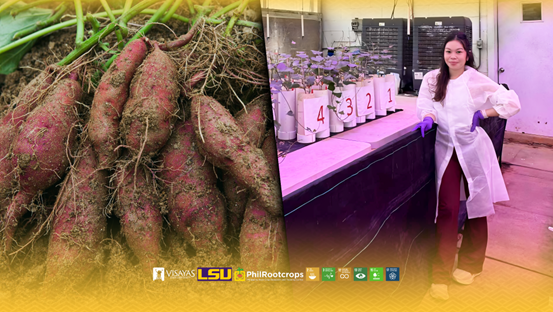#DiscoverWithVSU: VSU grad students help pinpoint lead-resistant sweetpotato in US study
- Details
- Written by Elmera Y. Bañoc
-
Published: 02 August 2025

A groundbreaking research led by young VSU scientists offers hope for a safer food in lead-affected soils.
In a significant step toward a safer food production, graduate students from Visayas State University (VSU) studying at Louisiana State University (LSU) have identified a sweetpotato cultivar that absorbs less lead from contaminated soils.
Leading this discovery is Mae Ann Bravo who is currently deepening her scientific training in the United States under the mentorship of Dr. Arthur Villordon, together with a diverse team of scientists in plant physiology, chemistry, and soil science.
Their study focused on how two common sweetpotato cultivars respond to lead exposure, a problem that continues to threaten food safety in many parts of the world.
Sweetpotatoes, a staple root crop in numerous countries including the Philippines, are grown underground that make them particularly vulnerable to absorbing harmful substances like lead. And yet, the way different varieties deal with this challenge has been poorly understood.
To fill this gap, Bravo and her team studied two widely grown U.S. sweetpotato varieties called Bayou Belle and Beauregard under greenhouse conditions that mimicked naturally occurring lead levels found in agricultural soils in southern states like Louisiana.
Over 50 days, they tracked how the root systems of these plants developed and how much lead ended up in the parts of the plant people eat.
The results were clear. Bayou Belle showed stronger root growth and a lower ability to absorb lead into its storage roots, even when grown in lead-contaminated soil. This suggests that its root structure plays a protective role in preventing lead from making its way into the food chain.
On the other hand, Beauregard absorbed significantly more lead, up to 300 times more than plants grown in clean soil.
For Bravo, this difference means more than just numbers in a research paper.
“We are talking about the possibility of growing safer food even in polluted environments. “That is something that could benefit farmers and consumers in many countries, including our own.” she said.
The research not only opens up the opportunity to breed new sweetpotato varieties that are less likely to accumulate heavy metals, but also raises awareness about the importance of matching the right crop variety to the right environment, especially in places where soil contamination is a concern.
The team’s work also suggests that root traits, like length and branching, might influence how plant absorb harmful substances.
It is a window into how nature can be used to minimize risk in agriculture, especially in areas affected by mining, industrial waste, or past pesticide use.
The Director of the Philippine Root Crops Research and Training Center (PhilRootcrops) Mr. Marlon M. Tambos believes this research offers a pathway worth pursuing in the Philippines.
“This kind of work can guide us in choosing or developing sweetpotato varieties that are not only productive but also safer to eat, especially in regions where soil quality is already compromised,” he said.
PhilRootcrops, in partnership with the researchers from LSU, is already considering how this finding could be applied locally.
With the proper process for variety acquisition and field testing, this lead-resistant cultivar could eventually be introduced in the country, either as an imported line or as inspiration for breeding efforts using native varieties.
The study brought together researchers from different fields including Marissa Barbosa, Lisa Arce, Brenda Tubana, Don Labonte, and Arthur Villarondon from LSU, Jack Baricuatro from LSU-Shreveport, and Bravo’s fellow VSU alumnus.
While the research was conducted under the controlled greenhouse conditions, the lead levels used in the study reflect what is already present in real-world farms. That makes the work highly applicable, especially for rural communities growing food in places where soil has long been exposed to pollution.
For Bravo and her team, this research was not simply an academic exercise. It was an act of service driven by the desire to solve problems that affect ordinary people.
“Sometimes solutions are right there in the crops we grow,” Bravo added. “We just need to look closer.”
This discovery, born from curiosity, persistence, and the guidance of seasoned scientists, is a powerful reminder that even the most familiar crops still have secrets waiting to be uncovered. And those secrets may one day help feed us safely in a world facing environmental challenges on many fronts.
This article is aligned with the Sustainable Development Goals (SDG) No. 2: Zero Hunger; SDG 3: Good Health and Well-being; SDG 12: Responsible Consumption and Production; SDG 13: Climate Action; SDG 15: Life on Land, and; SDG 17: Partnership for the Goals.

